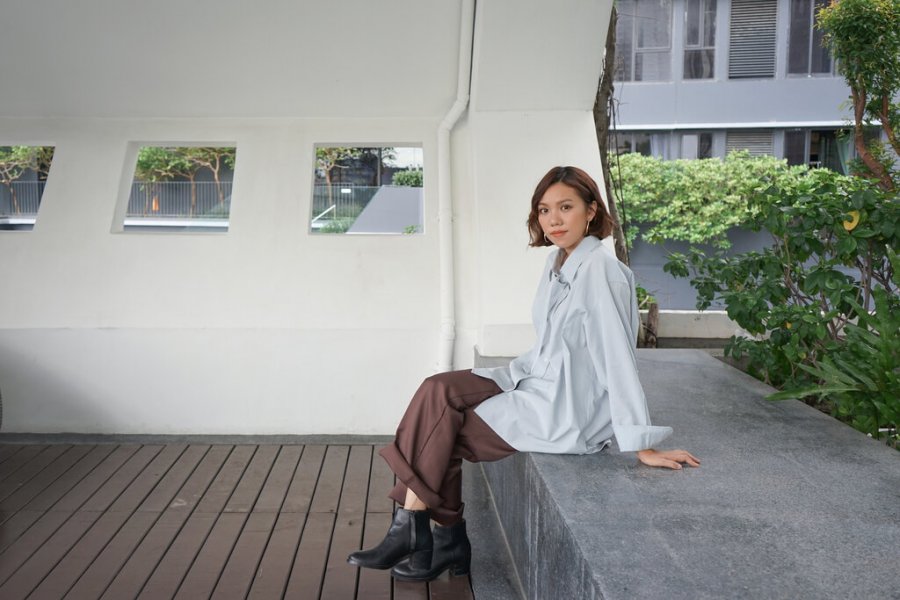Meet Thailand’s “30 Under 30” designer shining light on the dark side of fashion
Sparking a fashion revolution.
Named to the Forbes 30 Under 30 Asia list this year, Kamonnart Ongwandee is a fast-rising fashion designer, sustainability advocate, and country coordinator for the pioneering Fashion Revolution movement in Thailand. We caught up with her to learn more about the dark side beneath the glamor of fast fashion.
Fashion Revolution is a global movement that was formed after the collapse of Rana Plaza, a garment factory in Bangladesh, back in 2013. That incident raised awareness among fashion designers about inequality and injustice in our supply chains. At the time, I was working in the fashion industry and about to go to the UK to study textiles in grad school [at the Royal College of Art in London]. During my time there, I was volunteering as a university representative to build a movement around these issues. I had a chance to meet the founders of Fashion Revolution, and when I got back to Thailand, I noticed that we didn’t have a team, so they encouraged me to form one.
At the beginning, it was only me and one other person, who runs a social enterprise that focuses on textiles. After a while, our network got more diverse, but the majority of the members are millennial women with an interest in fashion, styling, and fabric. Some of them were already conscious consumers—they’re mindful of food, waste, and products they’re using in general.
It affects the environment on so many levels. For starters, most garments are made of cotton, and cotton is grown as a monoculture. It’s intensely taxing on land resources and water, involving pesticides and other chemicals, which really take a toll on the ecosystem. Before the weaving process, cotton needs to be washed and dyed, and those stages require tons and tons of water. The irony is we barely have enough fresh water to consume. Also, the life cycle of fast fashion products is short and clothes take ages to decompose, with all the buttons and zippers. That’s why fast fashion is such a big part of the global waste problem. Lastly, there’s pollution.
You can begin by making the most of your closet. When we’re purchasing new pieces, we often think that we’re bored with our old ones. You can find new joy in your wardrobe by styling fresh looks from your once-loved clothes. If you’re really sick of your old stuff, try swapping items with your friends. We host Clothes Swap, an event where you dig up clothes from the back of your closet and swap them with others. These days, most clothes that I wear came from Clothes Swap, and I feel like it’s an easy solution that costs you almost nothing.
When you have a formal event to attend, you can opt for a clothing rental service like Bchu Runway. You can also have your gowns made at a tailor shop—that would be beneficial for small businesses. At the end of the day, buying new clothes is not the end of the world, but I want it to be your last choice. [But] try to support more local businesses and emerging designers rather than big conglomerates that exploit labor and the environment.
Lastly, invest in designer goods and know that they’ll make you happy every time you wear them. When you think about it, if you buy 10 items that cost about B300-400/piece, but you get bored after wearing them for a while, that’s so wasteful. You could instead buy a piece that costs about B3,000-4,000 but know that you’ll cherish it longer. Nowadays, shopping is easier than ever, how many times have you ended up regretting your online purchases?

The feedback was unexpectedly good. There were more than 200 participants and over 5,000 items swapped. This time, we started to see more young people talking about the event, and we got a lot of attention from fresh-faced fashion influencers as well.
Fashion Revolution raises awareness with events, documentary screenings, talks from guest panels, and such. Meanwhile, SEAM is a special project that was created in order to fulfill the missing piece in our cause, which is the mindset. We’ve learned that just pointing out a bunch of information isn’t really enough to change habits, I mean, we’re all aware of the impact of fast fashion, but it’s hard to just go cold turkey, and that’s when SEAM comes into play. We’d like to encourage you to make changes without feeling pressured, so the project emphasizes learning activities, workshops, and field trips. It’s like a community where we take you on a journey, starting from “self awareness” sessions (getting to know yourself and your consumption behavior) and “nature awareness” sessions (understanding natural fibers) to “community awareness” sessions (learning about different communities). Apart from that, this project will support us financially, so we can carry on doing our work for Fashion Revolution Thailand.
SEAM [laughs]. We developed this project because we think setting your mindset is fundamental [to creating lasting change]. We want to tighten the loop between producers and consumers by focusing on reducing, repairing, swapping, and supporting local businesses. On that account, we’re trying to bridge the gap between local artisans and young people. You don’t have to avoid consuming fast fashion 100-percent; you can just adjust the portion of your closet to include more pieces from local designers and artisans.
Advertisement